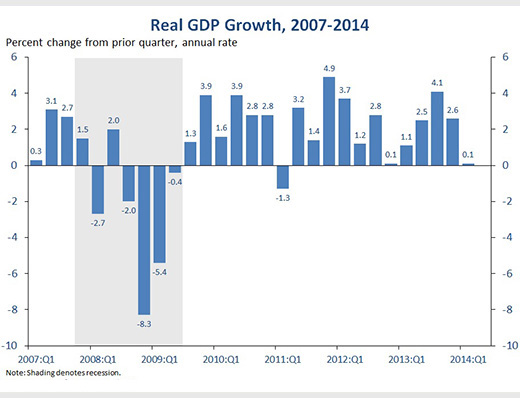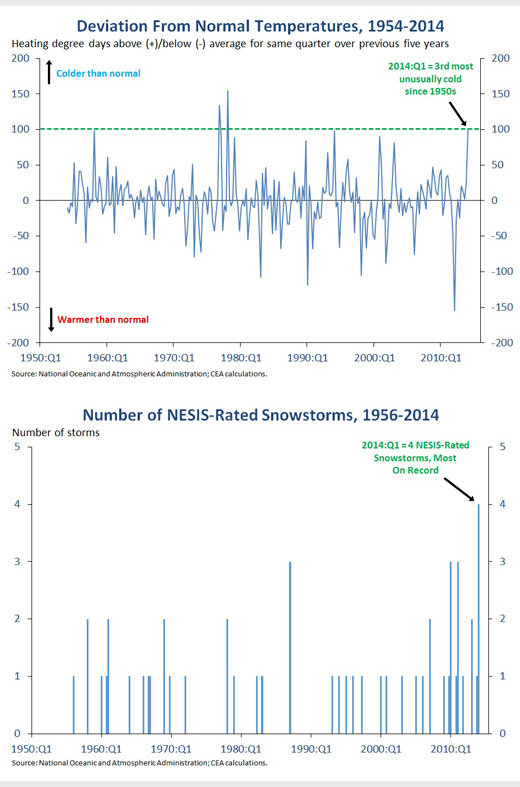
Today’s GDP estimate is subject to a number of notable influences, including historically severe winter weather, which temporarily lowered growth in the first quarter. The report also shows the positive impact of the implementation of the Affordable Care Act which, together with continued slowing in health costs, helped strengthen the economy in the first quarter. The President will do everything he can either by acting through executive action or by working with Congress to push for steps that would raise growth and accelerate job creation, including fully paid-for investments in infrastructure, education and research, a reinstatement of extended unemployment insurance benefits, and an increase in the minimum wage.
FIVE KEY POINTS IN TODAY’S REPORT FROM THE BUREAU OF ECONOMIC ANALYSIS
1. Real gross domestic product (GDP) rose 0.1 percent at an annual rate in the first quarter of 2014, following the 3.4 percent annual pace in the second half of 2013. Looking at the various components of GDP, consumer spending grew at a rapid pace, mainly reflecting sharp increases in health care and utilities consumption, while the other elements of consumer spending on net rose only slightly. Consumer spending on food services and accommodations fell for the first time in four years, one of several components that was likely affected by unusually severe winter weather. Exports and inventory investment, two particularly volatile components of GDP, also subtracted from growth.

2. The first quarter of 2014 was marked by unusually severe winter weather, including record cold temperatures and snowstorms, which explains part of the difference in GDP growth relative to previous quarters. The left chart shows the quarterly deviation in heating degree days from its average for the same quarter over the previous five years. By this measure, the first quarter of 2014 was the third most unusually cold quarter over the last sixty years, behind only the first quarter of 1978 and the fourth quarter of 1976. In addition, there were four storms in the first quarter that rated on the Northeast Snowfall Impact Scale (NESIS). The right chart shows that no quarter going back to 1956 had more than three such storms.

3. Within the first quarter, several key indicators were lower in January and/or February before rebounding strongly in March, suggesting that the severe weather had a disruptive effect that only began to abate at the end of the quarter. Light vehicle sales, average weekly hours, core retail and food service sales, and core capital goods shipments dipped starting in December and/or January before bouncing back in March, and so were left little changed for the quarter as a whole. One outside group has estimated that the elevated snowfall in the first quarter slowed the annual rate of GDP growth by 1.4 percentage points, with all of that lost activity to be made up in the second quarter.
Additionally, it is worth noting that consumer spending on utilities surged more than 38 percent at an annual rate in the first quarter, the largest increase on record (with data back to 1959). While this weather-related jump in utilities spending added to GDP growth, it was likely more than offset by the constraining effect of severe weather on other categories, including other components of consumer spending (like autos, household furnishings, and restaurants), some components of private and public fixed investment, and exports.

4. The federal sector made a small positive contribution to growth for the first time in over a year, in part because the effect of the shutdown in the fourth quarter reversed. The Bureau of Economic Analysis (BEA) reported that in the fourth quarter, federal worker furloughs resulting from the government shutdown directly reduced GDP growth by 0.3 percentage point at an annual rate; other effects of the shutdown (including reduced government purchases of goods and services) also likely contributed to the large 1.0 percentage point negative contribution from the federal government.
In the first quarter of 2014, the federal sector made a small (0.05) percentage point positive contribution to growth, in part due to the return to a full quarter of undisrupted federal employee work hours. Federal spending is subject to a number of influences, including the winding down of overseas military operations, the withdrawal of temporary support measures enacted earlier in the recovery, and in 2013, the sequester. The budget agreement reached late last year should create a more neutral fiscal climate in 2014 than in 2013, and while there is still a need to do more to invest in growth, the reduced fiscal drag is a key reason that outside forecasters expect growth to strengthen over the remainder of the year.

5. Health care prices continued to increase exceptionally slowly, growing at an annual rate of just 0.5 percent (0.9 percent on a year-over-year basis), while utilization (real health care spending) rose at a 9.9 percent annual rate in the first quarter. It is important to note that the main survey BEA uses to track health care spending will not report first-quarter estimates until June, and the expansion of insurance coverage under the Affordable Care Act during the first quarter complicates the interpretation of other available data. For this reason, today’s estimates could be revised significantly.
If anything, however, the details of today’s report suggest that the underlying cost trends in the health sector remain favorable. The sharp increase in estimated utilization appears to have been driven by greater use of health care services by people who gained insurance coverage during the first quarter because of the Affordable Care Act. Ensuring access to care is a key goal of the Affordable Care Act’s coverage expansion, so this increase in utilization is neither a surprise, nor a cause for concern. Furthermore, any upward pressure on health care spending growth from expanding insurance coverage will cease once coverage stabilizes at its new, higher level, so it does not affect the longer-term outlook for spending growth.
Meanwhile, consumers continued to benefit from very slow growth in health care prices, a trend that actually deepened during the first quarter and which is attributable in part to reforms made in the Affordable Care Act. Slower growth in health care prices drives slower growth in families’ out-of-pocket costs and insurance premiums and has been an important contributor to the overall slow growth in health care spending seen over the last few years.



